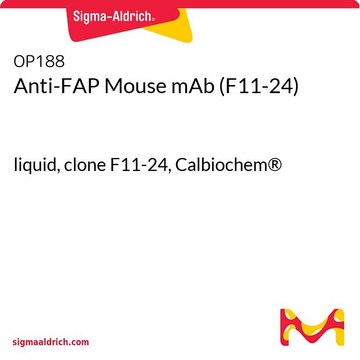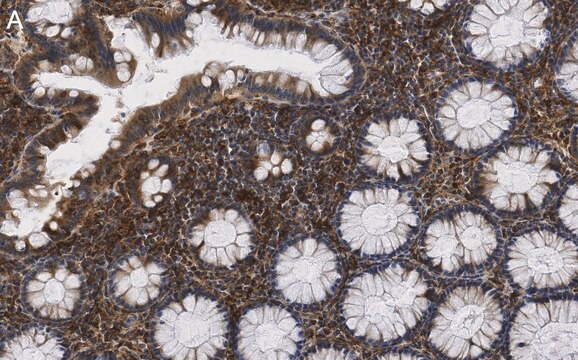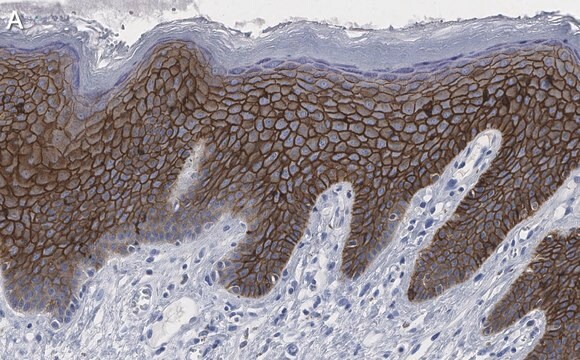MABT366
Anti-Claudin-1/CLDN1 Antibody, clone 7A5
clone 7A5, from mouse
Synonim(y):
Claudin-1, Senescence-associated epithelial membrane protein
About This Item
Polecane produkty
pochodzenie biologiczne
mouse
Poziom jakości
forma przeciwciała
purified immunoglobulin
rodzaj przeciwciała
primary antibodies
klon
7A5, monoclonal
reaktywność gatunkowa
human
spodziewany brak reakcji z
mouse
metody
flow cytometry: suitable
immunocytochemistry: suitable
western blot: suitable
izotyp
IgG1κ
numer dostępu NCBI
numer dostępu UniProt
Warunki transportu
dry ice
docelowa modyfikacja potranslacyjna
unmodified
informacje o genach
human ... CLDN1(9076) , NISCH(11188)
Opis ogólny
Specyficzność
Immunogen
Zastosowanie
Western Blotting Analysis: 0.5 µg/mL from a representative lot detected exogenously expressed claudin-1 in CLDN1-transfected, but not mock-transfected, HT1080 cells (Courtesy of Professor Masuo Kondoh, PhD, Osaka University, Japan).
Immunocytochemistry Analysis: A representative lot immunostained the surface of Huh-7.5.1 human hepatoma cells, but not the non-claudin-1-/CLDN1-expressing S7-A cells (Fukasawa, M., et al. (2015). J. Virol. 89(9):4866-4879).
Flow Cytometry Analysis: A representative lot specifically immunostained HT1080 cells expressing exogenously transfected human claudin-1 (CLDN1), but not HT1080 cells expressing human claudin-2, -4, -5, -6, -7, or -9, nor L cells expressing mouse claudin-1 (Fukasawa, M., et al. (2015). J. Virol. 89(9):4866-4879).
Flow Cytometry Analysis: A representative lot immunostained HEK293T transfectants expressing FLAG-tagged human claudin-1/CLDN1 and human-mouse claudin-1 chimeras with the second human extracellular loop (EL2), but not chimeras with the mouse EL2. M152L, but not V155I, mutation in human EL2 abolished the immunoreactivity (Fukasawa, M., et al. (2015). J. Virol. 89(9):4866-4879).
Western Blotting Analysis: A representative lot detected FLAG-tagged human claudin-1/CLDN1 and human-mouse claudin-1 chimeras with the second human extracellular loop (EL2), but not chimeras with the mouse EL2. M152L, but not V155I, mutation in the second human extracellular loop abolished the immunoreactivity (Fukasawa, M., et al. (2015). J. Virol. 89(9):4866-4879).
ELISA Analysis: A representative lot detected claudin-1/CLDN1 immunoreactivity in 3.7% formaldehyde-fixed Huh-7.5.1 human hepatoma cells by "cell ELISA" (Fukasawa, M., et al. (2015). J. Virol. 89(9):4866-4879).
Neutralization Analysis: A representative lot inhibited HCV infection of cultured Huh-7.5.1 human hepatoma cells in vitro and of human liver-chimeric mice in vivo (Fukasawa, M., et al. (2015). J. Virol. 89(9):4866-4879).
Cell Structure
Infectious Diseases - Viral
Jakość
Immunocytochemistry Analysis: 10 µg/mL of this antibody detected Claudin-1/CLDN1 in HepG2 cells.
Opis wartości docelowych
Postać fizyczna
Przechowywanie i stabilność
Handling Recommendations: Upon receipt and prior to removing the cap, centrifuge the vial and gently mix the solution. Aliquot into microcentrifuge tubes and store at -20°C. Avoid repeated freeze/thaw cycles, which may damage IgG and affect product performance.
Inne uwagi
Oświadczenie o zrzeczeniu się odpowiedzialności
Nie możesz znaleźć właściwego produktu?
Wypróbuj nasz Narzędzie selektora produktów.
polecane
Kod klasy składowania
12 - Non Combustible Liquids
Klasa zagrożenia wodnego (WGK)
WGK 2
Temperatura zapłonu (°F)
Not applicable
Temperatura zapłonu (°C)
Not applicable
Certyfikaty analizy (CoA)
Poszukaj Certyfikaty analizy (CoA), wpisując numer partii/serii produktów. Numery serii i partii można znaleźć na etykiecie produktu po słowach „seria” lub „partia”.
Masz już ten produkt?
Dokumenty związane z niedawno zakupionymi produktami zostały zamieszczone w Bibliotece dokumentów.
Nasz zespół naukowców ma doświadczenie we wszystkich obszarach badań, w tym w naukach przyrodniczych, materiałoznawstwie, syntezie chemicznej, chromatografii, analityce i wielu innych dziedzinach.
Skontaktuj się z zespołem ds. pomocy technicznej








